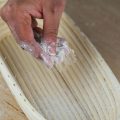Are you curious about freezing sourdough bread while maintaining its mouthwatering flavor and delightful texture? Look no further! We’re here to unravel the secrets of freezing this beloved bread. Sourdough bread is renowned for its tangy taste and chewy consistency, making it a favorite among bread enthusiasts. But what if you have leftovers or want to stock up for later? Freezing sourdough bread can be a convenient solution, preserving its quality and allowing you to relish it at your convenience. Stay tuned as we delve into the best practices and tips for freezing this artisanal treasure.
![Can You Freeze Sourdough Bread [Top Ways!] 1 Can you freeze sourdough bread [top ways! ]](https://www.mydailysourdoughbread.com/wp-content/uploads/2023/06/can-you-freeze-sourdough-bread-720x405.jpg)
Table of Contents
- Can You Freeze Sourdough Bread?
- Why Freeze Sourdough Bread?
- Does Freezing Affect Sourdough Bread?
- How Long Can You Freeze Sourdough Bread For?
- How to Freeze Sourdough Bread?
- How to Thaw & Refresh Sourdough Bread?
- Freezing Sourdough
- FAQs
Can You Freeze Sourdough Bread?
Short answer is yes, you can indeed freeze sourdough bread.
Read on to learn more about the many ways you can do this to extend the life of your sourdough loaf.
Why Freeze Sourdough Bread?
There are several reasons why freezing sourdough bread can be advantageous.
Here are a few key benefits:
- Preservation: Freezing sourdough bread helps extend its shelf life significantly. Instead of worrying about your bread going stale or molding within a few days, freezing allows you to store it for an extended period without sacrificing its quality.
- Convenience: By freezing sourdough bread, you can have a readily available stash of your favorite bread whenever you need it. It’s particularly useful if you have limited access to fresh sourdough or if you want to stock up during busy periods.
- Minimizing waste: If you find yourself with leftover sourdough bread that you won’t consume in time, freezing it can prevent unnecessary waste. You can simply thaw and enjoy it at a later date, reducing the chances of throwing away perfectly good bread.
- Enjoyment at your own pace: Freezing allows you to enjoy sourdough bread at your own pace. Whether you prefer to savor it slowly or have a slice whenever the craving strikes, freezing provides the flexibility to indulge in this delicious bread whenever you desire.
Does Freezing Affect Sourdough Bread?
Freezing can have some effects on sourdough bread, but with proper handling, its overall quality can be preserved quite well.
A few considerations to think about:
Texture
Freezing can cause slight changes in the texture of sourdough bread. Upon thawing, the bread may become slightly denser or lose some of its initial chewiness. However, these changes are usually minimal and may not be noticeable to everyone.
Moisture
Freezing can cause some moisture loss in sourdough bread. To mitigate this, it’s essential to store the bread properly to prevent excessive drying. Wrapping it tightly in plastic wrap or placing it in an airtight container before freezing helps retain moisture.
Flavor
Sourdough bread’s flavor can be affected to a certain extent when frozen. Some individuals report a slight decrease in the intensity of the bread’s tanginess after freezing.
However, this can vary, and many people still find the flavor enjoyable even after freezing.
Despite these potential effects, many sourdough enthusiasts find that freezing their bread is a worthwhile compromise for the convenience and extended shelf life it provides. Proper packaging, swift freezing, and attentive thawing can help minimize any negative impact and ensure the frozen sourdough bread remains a tasty treat.
![Can You Freeze Sourdough Bread [Top Ways!] 2 Can you freeze sourdough bread [top ways! ]](https://www.mydailysourdoughbread.com/wp-content/uploads/2023/06/freezing-sourdough-720x405.jpg)
How Long Can You Freeze Sourdough Bread For?
Sourdough bread can be frozen for a relatively long period if stored properly. When stored in the freezer at 0°F (-18°C) or below, sourdough bread can maintain its quality for up to three months.
However, it’s important to note that the bread is best enjoyed within the first month of freezing, as its texture and flavor may gradually deteriorate over time.
To maximize the shelf life of frozen sourdough bread, it’s crucial to follow a few guidelines:
- Packaging: Wrap the bread tightly in plastic wrap or aluminum foil to protect it from freezer burn and minimize moisture loss. Alternatively, you can place it in an airtight freezer-safe container or resealable bag.
- Freezer placement: Store the wrapped or packaged sourdough bread in the coldest part of your freezer to maintain its quality.
- Thawing: When ready to enjoy the frozen sourdough bread, allow it to thaw at room temperature, still wrapped, to prevent moisture loss. Avoid using a microwave or oven for thawing, as they can cause uneven heating and affect the bread’s texture.
Remember that freezing times and results may vary depending on the specific characteristics of your sourdough bread and freezer. It’s always recommended to assess the quality of the bread after thawing to ensure it meets your expectations.
How to Freeze Sourdough Bread?
To freeze sourdough bread properly and maintain its quality, follow these steps:
- Cool the bread: Allow the sourdough bread to cool completely after baking. Freezing warm bread can lead to excess moisture and potential freezer burn.
- Wrap the bread: Wrap the sourdough bread tightly in plastic wrap or aluminum foil. Ensure that the entire loaf is covered to protect it from freezer burn and moisture loss. Alternatively, you can place it in a resealable freezer bag or an airtight freezer-safe container.
- Label and date: It’s a good practice to label the wrapped bread with the date of freezing. This way, you can keep track of its storage time and prioritize consuming the oldest loaf first.
- Place in the freezer: Put the wrapped sourdough bread in the coldest part of your freezer, ideally in a single layer to allow for even freezing. Avoid stacking or squeezing the bread to prevent deformation.
- Freeze: Allow the bread to freeze completely, which typically takes a few hours. Once frozen, you can rearrange it as needed in the freezer to maximize space.
How to Freeze Sliced Sourdough Bread?
Freezing sliced sourdough bread is a convenient way to have individual portions ready for quick consumption.
Here’s a simple guide to freezing sliced sourdough bread:
- Slice the bread: Start by slicing the sourdough bread into your desired thickness. It’s recommended to have sliced bread it as you would for regular consumption, such as sandwich-sized slices or smaller for toasting.
- Prepare for freezing: Arrange the slices in a single layer on a baking sheet or a flat surface lined with parchment paper. Make sure the slices don’t touch each other, allowing for easy separation later.
- Pre-freeze (optional): For better preservation and to prevent slices from sticking together, you can pre-freeze the individual slices for about 1 to 2 hours. This will firm them up slightly before packaging.
- Packaging: Once the slices are pre-frozen (or if you choose to skip the pre-freezing step), transfer them into a freezer-safe bag or airtight container. Remove any excess air from the bag or container to minimize the risk of freezer burn. You can separate the slices with parchment paper or place them in individual sandwich bags for easier portioning.
- Label and date: Don’t forget to label the bag or container with the date of freezing to keep track of storage time.
- Freeze: Place the bag or container in the coldest part of your freezer and freeze until solid.
How to Thaw & Refresh Sourdough Bread?
Thawing and refreshing sourdough bread properly is crucial to restore its texture and taste.
Here’s a step-by-step guide:
- Remove from the freezer: Take the frozen sourdough bread out of the freezer and leave it wrapped while thawing to prevent moisture loss.
- Thaw at room temperature: Place the wrapped bread on a countertop or cutting board at room temperature. Allow it to thaw completely. Depending on the size of the loaf or slices, thawing may take a few hours.
- Unwrap and assess: Once thawed, remove the plastic wrap or packaging from the bread. Inspect the loaf or slices to ensure there are no signs of freezer burn or excessive moisture.
- Refresh the crust (optional): If you desire a crispier crust, you can refresh the bread by preheating your oven to around 350°F (175°C). Lightly spritz the bread with water or brush it with a little water to moisten the crust. Place the bread in the oven for a few minutes until the crust becomes crispy. Be careful not to overheat or dry out the bread.
- Enjoy or reheat (optional): Sourdough bread is delicious when enjoyed as is, especially when it has a chewy texture and tangy flavor. However, if you prefer warm bread, you can gently reheat it in a toaster, toaster oven, or conventional oven for a few minutes. Avoid overheating to prevent excessive drying.
Freezing Sourdough
Freezing baked sourdough bread can be a convenient solution to extend its shelf life and reduce waste. By following proper freezing, thawing, and refreshing techniques, you can enjoy the tangy, chewy goodness of sourdough bread even after it has been frozen.
So go ahead and stock up on this beloved bread without hesitation!
Did you know that you can feed your sourdough starter? Check out my blog post on how to freeze sourdough starter to find out how!
FAQs
How Long Does Sourdough Bread Last In Fridge?
Sourdough bread stored in the fridge can typically last for about 5-7 days. The cold temperature helps to slow down the staling process. To maintain its freshness, it is best to keep the bread in an airtight bag or container to prevent it from drying out.
Can You Freeze Sourdough Bread Dough?
Yes, you can freeze sourdough bread dough. After shaping the dough, allow it to go through the initial rise. Then, wrap it tightly in plastic wrap or place it in an airtight container before freezing. When ready to bake, thaw the dough in the fridge overnight and proceed with the final rise and baking process to get a delicious sourdough loaf.





![How To Stretch And Fold Sourdough [A Detailed Guide] 6 How to stretch and fold sourdough [a detailed guide]](https://www.mydailysourdoughbread.com/wp-content/uploads/2023/06/How-To-Stretch-And-Fold-Sourdough-120x120.jpg)
